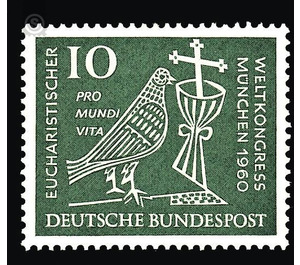World Eucharist Congress, Munich 1960 - Germany / Federal Republic of Germany 1960 - 10
Theme: Calender
| Country | Germany / Federal Republic of Germany |
| Issue Date | 1960 |
| Face Value | 10.00 |
| Color | green |
| Perforation | K 14 |
| Printing Type | Single-color Typography |
| Stamp Type | Postage stamp |
| Item Type | Stamp |
| Chronological Issue Number | 220 |
| Chronological Chapter | GER-BRD |
| SID | 909547 |
| In 69 Wishlists | |
The occasion for the publication of these two special postage stamps is the 37th Eucharistic World Congress, which will be held in Munich. A suitable motive was found among the results of an artists' competition which the art committee set up for the preparatory work for the congress had advertised for obtaining various advertising and advertising materials. The sculptor Max Faller submitted a small relief for a pin. This sign, which was initially given in plastic form with the inscription "pro mundi vita" proved to be suitable in terms of its content and allowed for an effective transposition into graphic form. Five artists were commissioned to use this symbol with dove and goblet and to develop a stamp from it. Bert Jäger received a draft, Prof. Eduard Ege and Mrs. Gerta Haller each delivered two proposals, while Wilhelm Neufeld contributed five and Arthur Schraml six solutions. Although it is without exception graphically successful achievements, the attention of the Art Advisory very soon focused on two works by Prof. Eduard Ege and Bert Jäger. The authors have managed to develop a considerable degree of independent creative power if they strongly follow the given model. The choice of the Art Advisory ultimately fell to the formulation of Prof. Eduard Ege, whose filigree linework remains transparent for the spiritual-religious world. The Federal Minister for the Post and Telecommunications has given his consent to the realization of these brands. They were executed in the monochrome intaglio printing process at the Bundesdruckerei Berlin and appear in the two values to be 10 Pf green and 20 Pf red.


